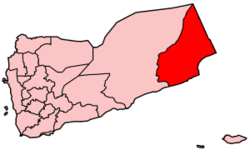Ann Chambers and Mahra Sultanate: Difference between pages
← Redirected page to New Democratic Party candidates, 2008 Canadian federal election#Vancouver South |
Adding geodata: {{coord missing|Yemen}} |
||
| Line 1: | Line 1: | ||
[[Image:ProtectorateOfSouthArabiaMap.jpg|right|thumbnail|380px|Map of the Protectorate of South Arabia in 1965]] |
|||
#REDIRECT [[New Democratic Party candidates, 2008 Canadian federal election#Vancouver South]] |
|||
[[Image:Yemen-Al Mahrah.png|thumbnail|250px|Map of contemporary Yemen showing Al Mahrah governorate.]] |
|||
The '''Mahra Sultanate of Qishn and Socotra''' ({{lang-ar|سلطنة المهرة في قشن و سقطرة}} [{{Unicode|Salṭanat Mahrah fī Qishn wa Suquṭrah}}]) or sometimes the '''Mahra Sultanate of Ghayda and Socotra''' (Arabic: سلطنة المهرة في الغيضاء و سقطرة [{{Unicode|Salṭanat Mahrah fī-l Ghayḍāʿ wa Suquṭrah}}]) was a [[sultan]]ate that included both the historical region of [[Al Mahrah Governorate|Mahra]] and the [[Indian Ocean]] island of [[Socotra]] in what is now eastern Yemen. It was ruled by the '''Banu Afrar''' ({{lang-ar|بنو عفرار}} [{{Unicode|Banū ʿAfrār}}]) [[dynasty]] and is sometimes called '''Mahra State''' in English. |
|||
The capitals of Mahra were [[Qishn]] in Mahra and [[Hadiboh|Tamrida]] (Hadiboh) on Socotra. During 1886 the sultanate became a British protectorate and later became a part of the [[Aden Protectorate]]. |
|||
In the 1960s, Mahra declined to join the [[Federation of South Arabia]] but remained under British protection as part of the [[Protectorate of South Arabia]]. In 1967, the sultanate was abolished and Mahra became part of newly independent [[South Yemen]] which united with [[North Yemen]] in 1990 to become the Republic of Yemen. Today the Mahra area (without Socotra) is the [[Al Mahrah Governorate]] of Yemen. |
|||
In addition to Arabic, [[Mehri language|Mehri]], a [[Modern South Arabian]] language is spoken in Mahra. Mahra shares with the neighbouring [[Dhofar]] in [[Oman]] cultural treats such as non Arab languages, the importance of [[frankincense]] and geographic and climatic ties as well, which distinguish these regions from the desert surrounding them, mostly due to the beneficial action of the [[khareef]] monsoon. |
|||
==External links== |
|||
*[http://www.crwflags.com/fotw/flags/ye_mahr.html Mahra State flag] |
|||
*[http://www.ohmygosh.on.ca/stamps/yemen/amahr68.htm Postage stamps] |
|||
{{coord missing|Yemen}} |
|||
[[Category:History of Yemen]] |
|||
[[Category:Former countries in the Middle East]] |
|||
[[Category:Sultanates]] |
|||
{{Yemen-geo-stub}} |
|||
{{MEast-hist-stub}} |
|||
[[fr:Sultanat Mahri de Qishn et Socotra]] |
|||
Revision as of 17:06, 11 October 2008


The Mahra Sultanate of Qishn and Socotra (Arabic: سلطنة المهرة في قشن و سقطرة [
Salṭanat Mahrah fī Qishn wa Suquṭrah]) or sometimes the Mahra Sultanate of Ghayda and Socotra (Arabic: سلطنة المهرة في الغيضاء و سقطرة [
Salṭanat Mahrah fī-l Ghayḍāʿ wa Suquṭrah]) was a sultanate that included both the historical region of Mahra and the Indian Ocean island of Socotra in what is now eastern Yemen. It was ruled by the Banu Afrar (Arabic: بنو عفرار [
Banū ʿAfrār]) dynasty and is sometimes called Mahra State in English.
The capitals of Mahra were Qishn in Mahra and Tamrida (Hadiboh) on Socotra. During 1886 the sultanate became a British protectorate and later became a part of the Aden Protectorate. In the 1960s, Mahra declined to join the Federation of South Arabia but remained under British protection as part of the Protectorate of South Arabia. In 1967, the sultanate was abolished and Mahra became part of newly independent South Yemen which united with North Yemen in 1990 to become the Republic of Yemen. Today the Mahra area (without Socotra) is the Al Mahrah Governorate of Yemen.
In addition to Arabic, Mehri, a Modern South Arabian language is spoken in Mahra. Mahra shares with the neighbouring Dhofar in Oman cultural treats such as non Arab languages, the importance of frankincense and geographic and climatic ties as well, which distinguish these regions from the desert surrounding them, mostly due to the beneficial action of the khareef monsoon.
External links
